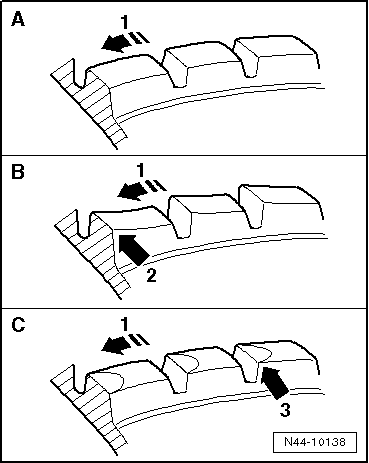Volkswagen Polo Service & Repair Manual: Heel and Toe Wear
| Heel-and-toe wear is step-like wear of individual tread
blocks, due to which an increased rolling noise can develop. The
heel-and-toe wear is caused by the uneven distortion of the
tread blocks in the contact patch. Heel-and-toe wear appears in
more extreme forms on non-tractive wheels than on tractive
wheels. Refer to → Fig.
„“Appearance of Heel-and-Toe Wear”“ |
| New tires have a stronger tendency to heel-and-toe wear,
because the high tread blocks have greater elasticity. As tread
depth decreases, the rigidity of the tread blocks increases and
the tendency to heel-and-toe wear decreases. |
|
|
|
| Appearance of Heel-and-Toe Wear |
| A - |
Tread blocks of a new tire; viewed in direction of travel
-arrow 1-, tread blocks have the
same height in front and rear. |
| B - |
Heel-and-toe wear; viewed in direction of travel
-arrow 1-, the tread blocks are
higher in front than in rear -arrow 2-. |
| C - |
Viewed in direction of travel -arrow
1-, tread blocks exhibit significant wear in forward area
of “heel-and-toe wear”-arrow 3-. |
| Extreme heel-and-toe wear may lead to customer complaints
about noise. |
| Increased heel-and-toe wear occurs with: |
| Tires which are not mounted on the tractive axle |
| Extreme driving style around curves. |
| When heel-and-toe wear occurs, the direction of travel of
the tire must be reversed. If increased heel-and-toe wear and
rolling noise develop, the tires should be rotated diagonally.
This leads to a reduction of heel-and-toe wear. |
| On vehicles with front wheel drive, this effect is increased
by increased wear on front axle. |
| The rolling noise is somewhat louder immediately after
rotating the wheels, but the normal noise level will be reached
after traveling approximately 500 to 1,000 km (310.68 to 621.37
miles). |
| In the event of increased heel-and-toe wear of the tires on
the rear axle - most common with front-wheel drive - rotate the
wheels from back to front. In the event of increased
heel-and-toe wear on the outer edges on one axle, reverse both
tires on their rims. Then the left wheel must be mounted on the
right side and the right wheel on the left side. |
|
|

|
High Speed Tires, Wear Characteristics
| These tires are designed for the highest speeds. Good
traction on wet roads is emphasized when developing these tires.
Tread compounds do not have the abrasion resistance of tires for
lower speeds, such as T and H tires. |
| Therefore the service life expectancy of high-speed tires is
substantially lower under comparable operating conditions. |
|
|
|
The following factors influence the service life of a tire
in varying degrees.
Driving style:
Speed
...
Note
When measuring tread depth, take measurements in the main
grooves.
Do not take measurements at the tread wear indicat ...
Other materials:
Silicone Remover
Definition:
Silicone Remover -LSW 019 000 A5-, watery
Silicone Remover -LVM 020 000 A5-
Silicone Remover, Long -LVM 020 100 A5-
Edition 02/2012
S ...
After changing a wheel
First read and observe the introductory
information and safety warnings
Clean the tools as necessary and place them back in the toolbox in the
luggage compartment .
Stow the spare wheel, temporary spare wheel or the removed wheel safely
in the luggage compartment.
The tight ...
Tire Sealant, Expiration Date
Tire sealant in the bottle has a limited storage life.
Therefore, the expiration date is indicated on the bottle
-arrow-.
Replace tire sealant when minimum shelf life date has been
...
© 2016-2025 Copyright www.vwpolo.net

 Tire Service Life, Influences
Tire Service Life, Influences Tread Depth, Measuring
Tread Depth, Measuring
